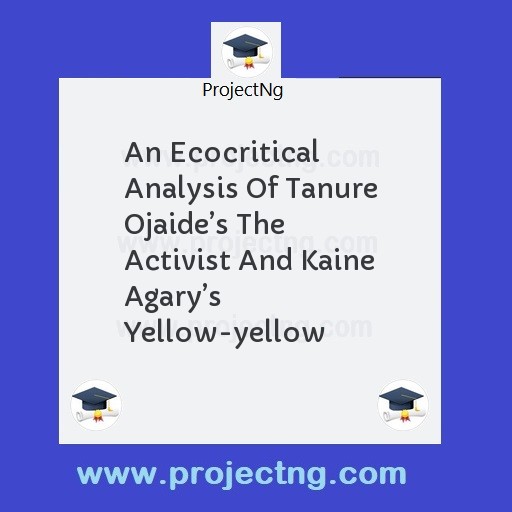An Ecocritical Analysis Of Tanure Ojaide’s The Activist And Kaine Agary’s Yellow-yellow
Education Project Topics
Get the Complete Project Materials Now! »
AN ECOCRITICAL ANALYSIS OF TANURE OJAIDE’S THE ACTIVIST AND
KAINE AGARY’S YELLOW-YELLOW
ABSTRACT
viii
Ecocoritical studies intensely show the relationship between man’s environment and
literature. In this way, ecocriticism becomes a standpoint that brings environmental discourse
to the fore within a literary context; a context that shows the exploitation and decay in man’s
environment. Following this assertion, the themes that border on environmental degradation
are routed in migration, pipeline vandalism, blowouts owing to gas flares and pollution. Most
of the analyses on the concept of ecocriticism take the direction of the greenish nature of the
environment and the extent of the marginalisation of a people. This research views ecocritism
from a different perspective. It depicts ecocritism as a theory that deploys the tools of
ecoactivism and resistance in the reading and analyses of Tanure Ojiade’s The Activist and
Kaine Agary’s Yellow-Yellow. It also shows the manner in which humans strive to unchain
themselves from the manacles that hold them bondage by resisting the discourse of
ecotrauma. This study also delves into the negative impacts of oil activities in the Niger Delta
region of Nigeria by connecting the ecocritical patterns of ecoactivism and resistance to the
utterances and actions of the characters in the texts.
1
CHAPTER ONE
INTRODUCTION
1.1 BACKGROUND TO THE STUDY
Man cannot be separated from his environment because his perception and interaction
with his surrounding make up his being. The destruction of the natural things that surround
man is caused by man himself by the acts of destroying and recreating his habitat. Thus,
ecocritical studies examine the way in which humans and the natural environment interact
and counter each other. Byron Caminero-Santangelo will comment in his essay that
‘Laurence Coupe sees ecocritism as an approach to literature which considers the relationship
between human and non-human life as represented in literary texts and which theorizes about
the place of literature in the struggle against environmental destruction’ (705).
The Niger Delta region of Nigeria is rich in crude oil, but it is in a state of
omnishambles because of ecological problems. The discovery, exploration and exploitation
of oil in the region have affected agriculture, fishing as well as the living conditions of the
people. With the leakage of oil from pipes and its spillage into lands, farms, and water, the
Niger Deltans are faced with a threatening disaster. Best Ordinohia and Seiyefa Brisibe note
that ‘oil spillage affected at least 1500 communities in the eight crude oil-producing states in
Nigeria, and were mainly from the 5284 oil wells that were drilled as at 2006 and the 7000
km of crude oil pipeline that cross the Niger Delta region. Oil spillage often results in
contamination of surface water with hydrocarbons and trace metals, as measured using
atomic spectrometry’(4). They further note that ‘the crude oil of the region contains some
naturally occurring radioactive materials. The crude oil spillage reduces soil fertility. It also
smothers economic trees and food crops, outrightly killing them or reducing their
2
yield causing a 60% reduction in household food security. The deterioration of the quality of
staple food leads to a 24% increase in the prevalence of childhood malnutrition’ (4). Crude
oil spillage also results in the bio-accumulation of heavy metals in surviving food crops like
cassava and pumpkin. Pat Okpoko in Environmental Impact of Technological Intrusion in
Nigeria notes that crops and economic trees affected by oil spillage show signs of scorching,
yellowing and shedding of leaves, stunted growth and death’ (4). He notes further that ‘fishes
caught from the polluted streams are often unpalatable and show signs of reduced growth and
reproductive performance and consequently decreased population’ (62).
When pushed to the wall, some Niger Deltans try to make the government and the
world to understand their predicament. This has led to untold violence, killing, maiming,
gunrunning, destruction and vandalism of pipelines, and the kidnapping of foreigners. Young
girls who cannot find jobs find succour in the hands of foreigners and wealthy Nigerian men
who after sleeping with them give them money that ought to be naturally theirs. Chris
Onyema notes that ‘since the discovery and commercial exploration of oil in this area in 1958
until date, the people of the Niger Delta have been suffering from acts of bioterrorism, oil
pollution of lands and water, gas flaring, hunger, diseases and poverty. Poverty breeds
prostitution, gas flaring breeds cancer and respiratory diseases’ (189). Sometimes, they feel
that violence is the only answer to their problem. After the amnesty that was granted to the
militants of Niger Delta, some of its indigenes still resort to thuggery. Ojaide says that ‘the
area boys were fighters attempting not only to reclaim what had been robbed from them, but
also holding firmly to what was theirs that others were attempting to snatch away’ (55). For
Ato Quayson, ‘violence becomes a means by which some people visit displeasure on those
associated with the state, particularly minor officials and those seen as colluding with it’ (58).
Also, Ngugi wa Thiong’o lends his voice to that of Quayson to say that ‘violence in order to
change an intolerant unjust social order is not savagery, it purifies man. Violence to protect
3
Be the First to Share On Social

Enjoying our content?
Don't miss out on new videos! Subscribe to our YouTube channel for more awesome content.
Subscribe Now!













